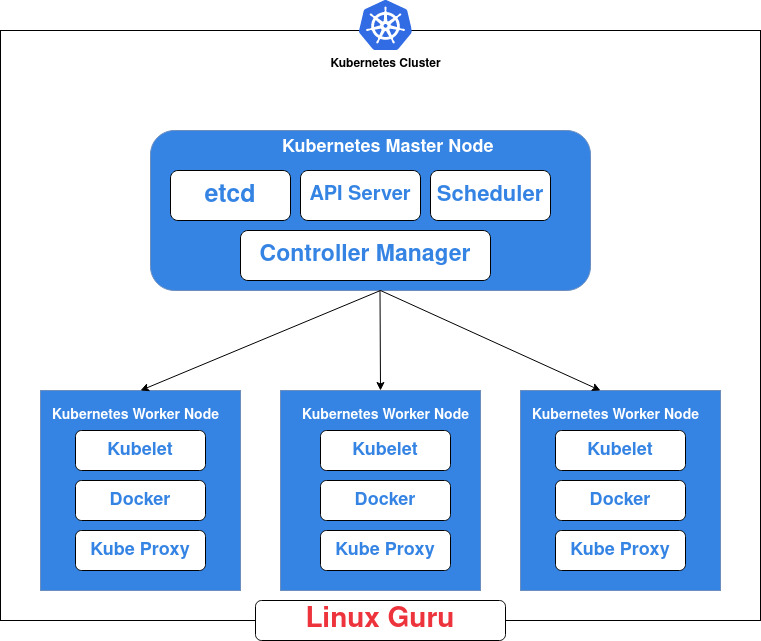Decoding Kubernetes: A Comprehensive Guide to its Core Components
Introduction:
Kubernetes, often referred to as K8s, is a powerful container orchestration platform that simplifies the deployment, scaling, and management of containerized applications. In this article, we’ll delve into the core components that make up the Kubernetes ecosystem, shedding light on the intricate web of services that work seamlessly to orchestrate containers. Checkout this post if you want to understand types of Kubernetes services.
Master Node:
In Kubernetes, a master node is a critical component of the cluster responsible for managing and controlling the overall state and configuration of the system. It is the brain of the Kubernetes cluster, handling the coordination of tasks and communication between various components. The master node oversees the entire orchestration process, ensuring that applications are deployed, scaled, and managed efficiently.
The key components of a Kubernetes master node include.
API Server:
- Acts as the control plane for the Kubernetes cluster, serving the Kubernetes API.
- The central management point for the Kubernetes cluster.
- Exposes the Kubernetes API, which users, other components, and external tools interact with to control the cluster.
etcd:
- A distributed key-value store that stores configuration data.
- Stores configuration data and the current state of the cluster, providing a reliable and consistent storage solution.
Controller Manager:
- Manages controllers to regulate the state of the cluster.
- Examples include the Node Controller (ensures nodes are healthy), Replication Controller (maintains the desired number of replicas), and Endpoints Controller (populates Endpoints objects).
Scheduler:
- Assigns work (containers) to nodes based on resource requirements and constraints.
- Optimizes the allocation of resources across the cluster to ensure efficient utilization.
Node (Minion/Worker) Node:
In Kubernetes, a worker node (also known as a minion node) is a component of the cluster responsible for running the actual workloads, which are typically containerized applications. Worker nodes host the containers that make up the application and contribute computing resources to the overall Kubernetes cluster. These nodes are an integral part of the distributed architecture that Kubernetes provides for deploying and managing containerized applications.
The Key components of a worker node include
Kubelet:
- Ensures that containers are running in a Pod on the node.
- The primary agent that runs on each worker node.
- Communicates with the Kubernetes control plane, specifically with the API server on the master node.
Container Runtime:
- The software responsible for running containers, like Docker or containerd.
- Interacts with the underlying operating system to start, stop, and manage containers.
Kube Proxy:
- Maintains network rules on nodes, enabling communication between Pods and external traffic.
- Enables communication between Pods on different nodes and allows external traffic to reach the Pods.
Kubernetes Objects
In Kubernetes, objects are persistent entities that represent the state of the cluster. These objects describe the desired state of a cluster or its components and can be used to create, update, or delete resources. The following are some of the common types of objects in Kubernetes:
Pod:
- The smallest deployable units in Kubernetes.
- Consists of one or more containers that share the same network namespace.
Service:
- Abstracts the access to a set of Pods, providing a stable endpoint for communication.
- Types include ClusterIP, NodePort, LoadBalancer, and ExternalName.
Volume:
- Provides data persistence for containers.
- Can be used by one or more containers in a Pod.
Namespace:
- A way to divide cluster resources between multiple users (via resource quota), or to partition resources within a user.
Deployment:
- Allows you to declaratively define and manage application deployments.
- Ensures a specified number of replica Pods are running at all times.
ConfigMap:
- Enables you to separate configuration details from application code.
- Can be used to store non-sensitive configuration data.
Secret:
- Stores sensitive information, such as passwords or API keys.
- Encoded or encrypted data that can be decoded by the Kubelet when mounting secrets into Pods. Learn more about Kubernetes secrets
Ingress:
- Manages external access to services within a cluster.
- Acts as a layer 7 (application layer) HTTP load balancer.
StatefulSet:
- Manages the deployment and scaling of a set of Pods, and provides guarantees about the ordering and uniqueness of these Pods.
These components work together to provide a robust and scalable container orchestration platform, allowing users to manage and scale containerized applications with ease. Understanding the role of each component is crucial for effective Kubernetes administration and application deployment.
Conclusion:
Kubernetes, with its rich set of components, offers a robust and scalable solution for container orchestration. Understanding these components is key to effectively managing and deploying containerized applications. In this article, we’ve explored the core components that form the backbone of Kubernetes, empowering you with insights to navigate the complex yet powerful world of container orchestration. As you embark on your Kubernetes journey, these components will serve as your guide to orchestrating containers with precision and efficiency.

Very well explained.
Informative content. Explain about k8s service types. Thank you!!!
Very easy and useful.